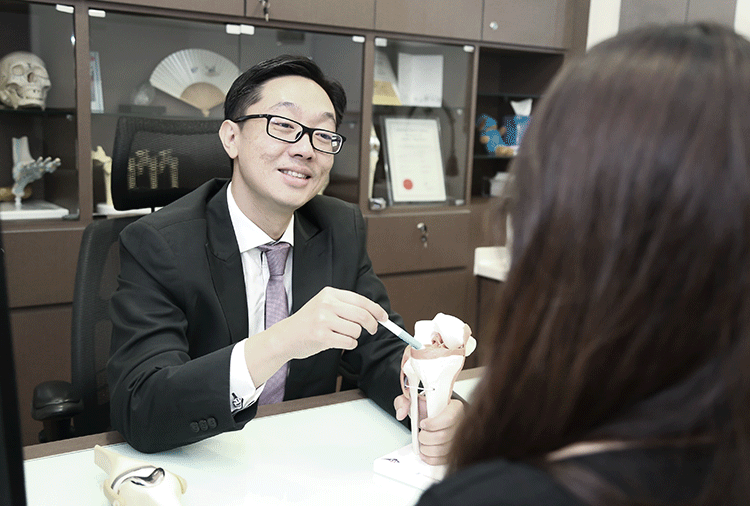Osteoarthritis is a common but often misunderstood condition that affects millions of people worldwide. Let’s break down the basics of hip osteoarthritis, exploring what it is, what causes it, and how it can impact your daily life.
Learn about the signs and symptoms to watch out for and offer practical tips on managing and preventing hip osteoarthritis. Whether you’re looking for information for yourself or a loved one, we’re here to provide you with clear and accessible insights into this joint condition.
What is Osteoarthritis of the Hip?
Osteoarthritis of the hip, often simply referred to as hip osteoarthritis, is a degenerative joint condition primarily affecting the hip joint. It is the most common form of arthritis and occurs when the protective cartilage that cushions the ends of the bones in the hip joint gradually wears down over time. As the cartilage deteriorates, the bones in the hip joint can rub against each other, leading to pain, stiffness, and reduced mobility.
Causes and Risk Factors
Common Causes and Contributing Factors
1. Age-Related Wear and Tear The primary cause of hip osteoarthritis is the natural ageing process. Over time, the hip joint’s cartilage becomes less resilient, making it more susceptible to wear and tear. This age-related degeneration can lead to the development of osteoarthritis.
2. Genetics and Family History
There is a genetic component to hip osteoarthritis. If you have a family history of this condition, you may be at a higher risk. Certain genetic factors can influence the integrity of the joint cartilage, making some individuals more predisposed to developing hip osteoarthritis.
3. Obesity and Excess Weight
Carrying excess body weight places additional stress on the hip joints. This added pressure can accelerate the breakdown of cartilage and increase the risk of developing hip osteoarthritis. Maintaining a healthy weight is crucial in managing and preventing this condition.
Less Common Causes and Risk Factors
1. Joint Injuries and Traumas
Significant hip injuries, such as fractures or dislocations, can disrupt the hip joint’s normal structure and increase the likelihood of osteoarthritis developing in the affected joint. Even after proper treatment, the joint may remain vulnerable to arthritis in the long term.
2. Congenital Hip Conditions
Some individuals are born with hip conditions or abnormalities that can predispose them to hip osteoarthritis later in life. Conditions like hip dysplasia, where the hip joint doesn’t develop properly, can lead to abnormal joint wear and arthritis over time.
Understanding the underlying causes and risk factors for hip osteoarthritis is essential for several reasons. Firstly, it can help individuals make informed lifestyle choices to reduce risk, such as maintaining a healthy weight and staying physically active. Secondly, it allows healthcare professionals to tailor treatment plans to address specific contributing factors.
Early Signs and Symptoms of Hip Osteoarthritis
Joint Pain and Stiffness
One of the initial indicators of hip osteoarthritis is persistent pain in the hip or groin area. This pain often starts as a mild discomfort but can gradually worsen over time. It is typically most noticeable during or after physical activity and may also occur at night, disrupting sleep. Stiffness in the hip joint is common, particularly in the morning or after periods of inactivity.
Reduced Range of Motion
Individuals with hip osteoarthritis may experience limitations in their ability to move the hip joint. This can manifest as difficulty when walking, climbing stairs or performing activities that involve hip movement. Reduced range of motion may also contribute to a limp or altered gait.
How Hip Osteoarthritis Progresses
Hip osteoarthritis is a progressive condition. As the disease advances, the symptoms tend to worsen. The gradual deterioration of the hip joint’s cartilage leads to increased friction between the bones, causing more pronounced pain, stiffness, and functional limitations. In some cases, bone spurs may form around the joint, further exacerbating discomfort and reducing mobility. Without proper management, hip osteoarthritis can significantly impact an individual’s daily life.
Impact on Daily Life and Quality of Life
Hip osteoarthritis can have a profound effect on an individual’s daily activities and overall quality of life. As the pain and stiffness intensify, people may find it challenging to engage in routine tasks such as walking, standing, or sitting for extended periods.
This can lead to decreased physical activity, social isolation, and a decline in overall well-being. Furthermore, hip osteoarthritis may interfere with the ability to participate in recreational activities and hobbies, impacting one’s enjoyment of life. Difficulty with mobility and discomfort can also affect job performance, making it challenging to maintain an active and independent lifestyle.
Recognising the symptoms of hip osteoarthritis early is crucial because early intervention and management strategies can help alleviate pain, improve function, and enhance the overall quality of life for individuals with this condition. If you or someone you know experiences these symptoms, it’s advisable to seek medical evaluation and guidance to address the condition effectively.
Diagnosis and Evaluation
Physical Examination
Diagnosis of hip osteoarthritis often begins with a thorough physical examination by a healthcare provider, such as an orthopaedic specialist or rheumatologist. During the examination, the healthcare professional will assess the hip joint’s range of motion, stability, and any signs of tenderness or swelling. They will also inquire about the patient’s medical history and the nature of their symptoms, including the location and intensity of pain.
X-rays
X-rays are a common imaging technique used to diagnose hip osteoarthritis and assess its severity. X-ray images can reveal changes in the joint structure, such as a narrowing of the joint space, bone spurs (osteophytes), and any damage to the bones or cartilage. These visual findings help confirm the diagnosis and provide valuable information about the extent of joint degeneration.
MRI Scans
In some cases, magnetic resonance imaging (MRI) scans may be recommended, particularly when there is a need for more detailed visualisation of the hip joint’s soft tissues, such as the cartilage and surrounding ligaments. MRIs can help assess the extent of damage and provide a comprehensive view of the joint’s condition. This imaging technique is especially valuable when surgical intervention is being considered or when there are atypical symptoms.
In addition to these diagnostic methods, specialists may use blood tests to rule out other conditions that can cause similar symptoms, such as rheumatoid arthritis. Once a diagnosis of hip osteoarthritis is confirmed, a tailored treatment plan can be developed to manage the condition and improve the patient’s quality of life. Early diagnosis and intervention are crucial for effectively managing hip osteoarthritis and minimising its impact on daily activities and mobility.
Treatment Options
Non-surgical Approaches
1. Lifestyle Modifications (Weight Management, Exercise)
Lifestyle changes are often the initial step in managing hip osteoarthritis. Maintaining a healthy weight is essential to reduce stress on the hip joint. Incorporating low-impact exercises like swimming or cycling can improve joint flexibility and strengthen surrounding muscles while minimising joint strain.
2. Physical Therapy Physical therapy is a fundamental non-surgical treatment for hip osteoarthritis. A physical therapist can create a customised exercise program to enhance muscle strength, joint mobility, and pain relief. They may also utilise modalities such as heat, ice, or ultrasound to reduce inflammation and enhance joint function.
3. Medications for Pain and Inflammation Over-the-counter pain relievers (like acetaminophen) and nonsteroidal anti-inflammatory drugs (NSAIDs) can help manage hip osteoarthritis-related pain and inflammation. Sometimes, specialists may prescribe stronger medications or recommend joint injections (corticosteroids or hyaluronic acid) for symptom relief.
Surgical Interventions
1. Hip Arthroscopy
Hip arthroscopy is a minimally invasive surgical procedure for treating specific hip conditions, including early-stage hip osteoarthritis. During arthroscopy, small incisions are made, and a camera is inserted to visualise and address issues within the hip joint. Procedures may involve removing damaged tissue, repairing labral tears, or addressing bone spurs.
2. Total Hip Replacement (Arthroplasty)
Total hip replacement is a more extensive surgical option reserved for severe hip osteoarthritis cases when non-surgical methods prove ineffective. This procedure replaces the damaged hip joint with an artificial prosthesis. Total hip replacement can significantly reduce pain and restore mobility, enabling individuals to regain their quality of life.
Choosing the Right Treatment Plan
Treatment choice depends on various factors, including the severity of hip osteoarthritis, the patient’s age, overall health, and lifestyle. Less invasive options are typically explored first, with surgery considered when conservative measures fail to provide relief. Specialists collaborate closely with patients to develop a personalised treatment plan aligning with their needs and goals.
Rehabilitation and Recovery
Rehabilitation is vital to the recovery process, regardless of the treatment received. Whether it involves physical therapy exercises, arthroscopy, or total hip replacement, patients undergo a rehabilitation program to improve strength, mobility, and function. The duration and intensity of rehabilitation vary depending on the treatment. Still, the ultimate objective is to help individuals regain independence and resume daily activities with reduced pain and improved joint function.
Individuals with hip osteoarthritis must work closely with their healthcare team to determine the most suitable treatment strategy, ensuring the best possible outcome for their condition and overall well-being.
Prevention and Lifestyle Changes
Lifestyle Modifications to Reduce the Risk of Hip Osteoarthritis
1. Healthy Eating Habits
- Maintain a balanced diet rich in nutrients, especially calcium and vitamin D, to support strong bones.
- Maintain a healthy body weight to reduce the load on your hip joints. Excess weight can increase the risk of osteoarthritis.
2. Regular Exercise
- Engage in low-impact exercises such as swimming, walking, or cycling to strengthen the muscles around your hip joint.
- Incorporate flexibility and range of motion exercises to keep your hip joint mobile.
- Avoid high-impact activities that may stress the hip joint, especially if you have existing hip issues.
Preventive Measures for Those at Risk
1. Protecting the Hip Joint from Injuries
- Be cautious during physical activities and sports to avoid traumatic hip injuries. Use proper protective gear when necessary.
- Maintain good posture and body mechanics to reduce unnecessary strain on the hip joint during daily activities.
- Use assistive devices like canes or walkers if needed to prevent falls, which can lead to hip injuries.
2. Early Intervention for Hip-Related Conditions
- If you experience hip pain or discomfort, seek prompt medical attention. Early diagnosis and treatment of hip-related conditions can prevent them from progressing to osteoarthritis.
- Follow your healthcare provider’s recommendations to prevent worsening conditions like hip bursitis or labral tears.
While these lifestyle changes and preventive measures can reduce the risk of hip osteoarthritis, there is no foolproof way to guarantee its prevention. Genetics and other factors can also play a role in the development of this condition. Regular check-ups with a healthcare provider can help at-risk individuals identify and manage potential issues early.






